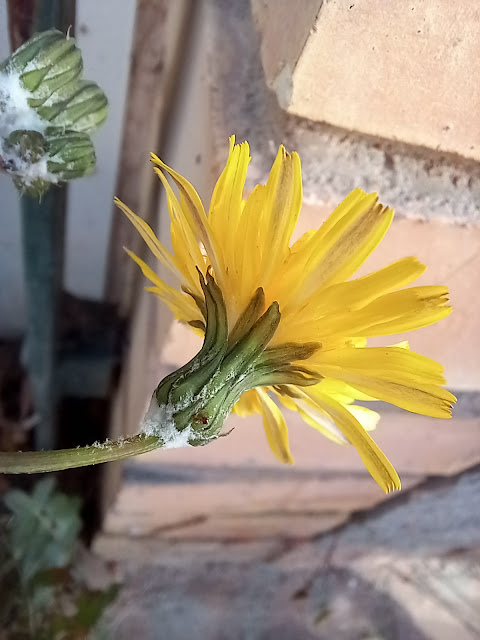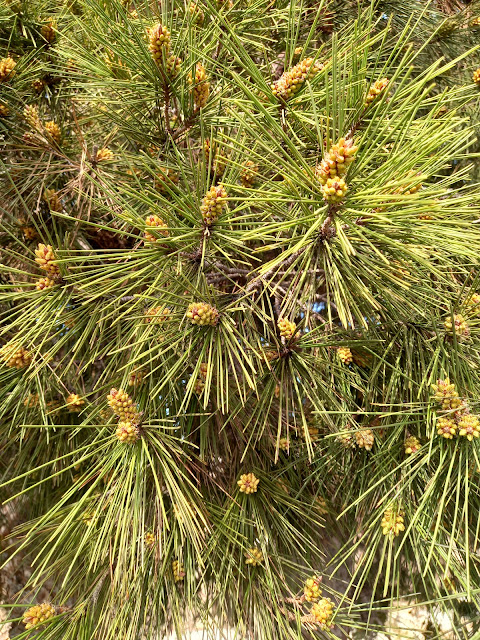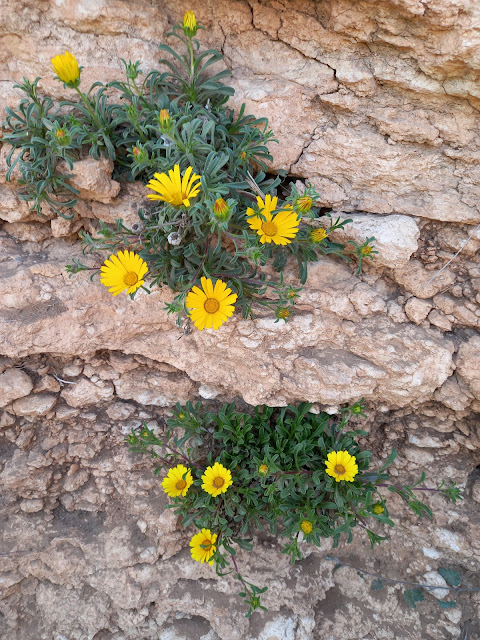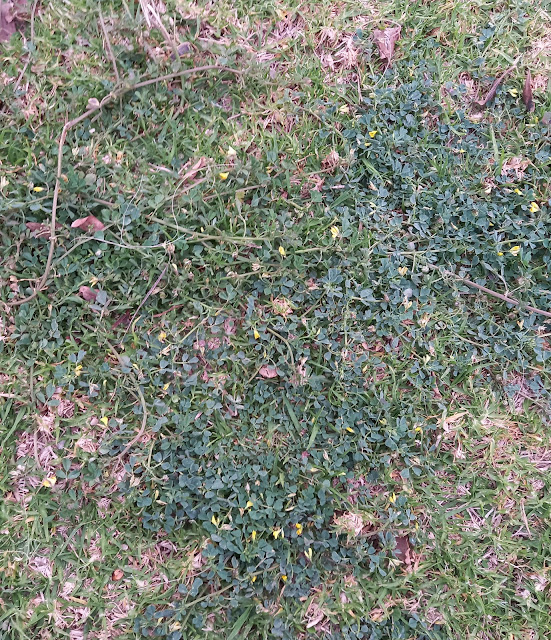A Stork's-bill. I'll have a guess at Erodium chium. (Other leaves I've seen are more distinctly lobed than the ones in this pic.)
Well this one's easy at least. It's the ridiculously pretty blue form of Scarlet Pimpernel (Anagallis arvensis), with hairy margins to petals.
Blue-leaved Wattle (Acacia cyanophylla), native to W. Australia. A major part of the coastal scenery at this time of year.
Pretty confident this is Euphorbia segetalis, though I wish Grey-Wilson had been more specific about the height than "short". Anyway, it's a common spurge round here.
[I should say, I was pretty confident. These plants must be about 50cm, taller than most heights quoted online for E. segetalis (though they're a mixed bag). Also these plants don't look like annuals to me.]
The vicious fruits of Small Caltrops aka Maltese Cross (Tribulus terrestris). I picked them out of my hand after steadying myself to photograph the spurge.
More about caltrops:
Unopened male flowers of the local pine (Aleppo Pine, Pinus halepensis).
More about it here:
Bermuda Buttercup (Oxalis pes-caprae). Introduced from South Africa to Malta in c. 1806, and soon a common sight around most of the Med, spreading vegetatively to form dense patches.
Yellow Sea Aster (Asteriscus maritimus), growing on a cliff wall.
It has other names. More about it here:
Don't know. It's very common, though. Every time I flick through Marjorie Blamey's pictures I hover over Urospermum dalechampii but that's supposed to be sulphur yellow and have backward-pointing leaf lobes, so no.
Purple Viper's Bugloss (Echium plantagineum)... I think. One of the commonest plants round here. You can find it at almost all times of year, but March is when it looks prettiest.
(It's also in the pic at the top of the post.)
Growing on the close-mown promenade at Mar Azul. A medick, maybe Medicago littoralis.
I was on my own this time, so there was a relative flood of reading. I dived into a Spanish book that I'd bought the last time I was over, the Penguin Clásicos edition of El sí de las niñas by Leandro Fernández de Moratín, a comedy from 1806. I wrote about it in a separate post:
When I'd mopped up all possible entertainment value from Moratín's play I switched over to Swedish, a genre novel I picked up in a charity shop, Klar Himmel by Kristin Fägerskjöld. This was her first novel (2020); I think she's up to her fourth now. It's a saga, multiple times and narrators, revolving around three women during WW2 and a dark secret, set partly in Sweden and partly in England, just the thing for expanding my vocabulary. My Swedish is now at about the same level as my French: I relish an easy novel, but literary novels remain forbidding. I read more slowly and hence with more interest than if I was reading the same kind of book in English. (Consequently, I'm learning quite a bit about what life was like in Sweden and England in 1941.)

Reading Swedish being hard work for me, needing regular breathers, I spent more time than usual looking at the cover. It's a collage, bombers flying overhead while a girl in a summer dress walks her bike idyllically. That seems to allude to Léonie's bike rides in Lincolnshire, and it's her dress (red with white spots), but she would have been in uniform. I think the girl must represent all the female leads at once, and above all the reader, entering and delighting in the world of the novel. (The leads themselves are keen readers, always looking for a quiet corner.)
I spent a bit of time wondering about the leaves, too. I don't recognize them; not a European tree, I'm thinking. Shutterstock creates strange new worlds.
Mind you, when Léonie arrives on her bike at the old ruin in the spring of 1944, "the daffodils and goldenrods competed to see which were the most numerous..." That feels a bit like a collage, too.
*
Meanwhile, I finally managed to finish off a post that's taken me forever, about Scott's inexhaustible novel The Heart of Midlothian.
Torrevieja is a multi-lingual sort of place, and you hear a lot of Nordic languages being spoken. The first euros I made, I was singing Den första gång jag såg dig ... I was delighted to finally add a new currency to my income history, to go with sterling and kronor. I've been trying when in Europe the last couple of years, but never found the right place and time. Superficially, conditions didn't seem ideal here either, down on the seafront, which was windy all week (I don't use any amplification, so wind, crashing waves and traffic are major considerations). Nevertheless, something unlocked in the cosmos and people started coming over, the coins came and even one note.
I cycled and ran but never felt like getting into the chilly sea. I made a batch of vegetable soup and mostly ate dinner in. But who could come here and resist tostada-tomate for breakfast, the occasional napolitana, the occasional krakauer...? My diary summarizes: Went to Bar El Botijo a few times, Elite a couple of times, Marco Polo (the one on C/ Scorpiones, handy for after shopping at Consum), El Carmen once, LaZia upstairs twice while using the launderette, Zenia Boulevard Bombon Boss twice, Miño (Av/ Desiderio Rodriguez) three times when heading Torrev direction. Andrea's bratwurst stall and our favoured restaurant whose name I think is Gelateria Italiana, though it's somewhat vague. (It's really a food place, with a German flavour to the menu; they stopped selling ice cream altogether when the electricity prices went mad, though I think it's back on now.)
Some other posts from visits to Torrevieja, including some of the same plants...
























2 Comments:
It's been quite a while since you published poetry, Michael. I've found a rich source:
https://rochereau.wordpress.com/2024/03/11/rain-stops-play/
and
https://rochereau.wordpress.com/2024/03/09/who-was-the-naughty-girl/
Would Roger McGough be on your radar?
Thanks for the links Vincent, I enjoyed reading those!
Post a Comment
<< Home